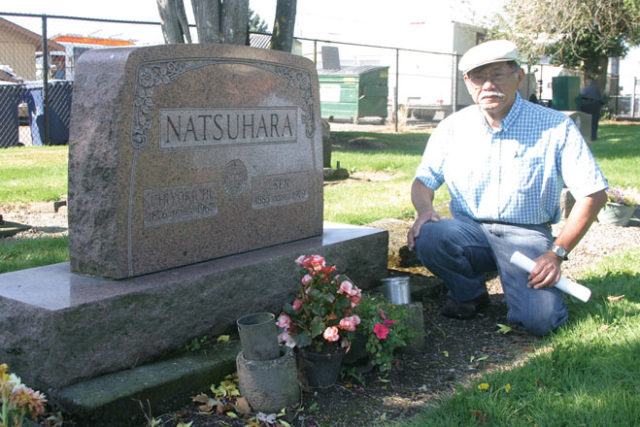
By Shihou Sasaki
The North American Post
The site’s long history began in the 1860s but now is mainly a Japanese cemetery, which is occupied by over 120 tombstones. Due to flooding, many families had decided to move their stones up the hill, but the 25-foot strip of the east edge of the site was granted to the White River Buddhist Temple in 1914 in exchange for their promise to take care of it.
According to the Auburn Landmark Commission, 432 Japanese Americans resided in the valley area in 1910, and the White River Buddhist Temple opened in 1912. At the same time, the community was seeking a site for burials.
The stewardship relationship between the temple and city has since continued. Families still remember the site and gather there for important occasions.
“Every Memorial Day, the members of the Terada, Tanabe, Kometani, Yamashita, Nishimoto, Natsuhara, Yamada, Sakagami and many other families gather to express their appreciation for their ancestors’ sacrifice and hard work so that the next generation can continue their legacy,” said Calvin Terada, who testified to the landmark commission in early August.
Terada, president of Kumamoto Kenjin Kai and vice president of Seattle Betsuin Buddhist Church, can see more than 10 headstones of the Terada, Tanabe and Kometani families that are all his family and ancestral members.
“Auburn’s Pioneer Cemetery is really the closing chapter to the story of my ancestors and many of the other Japanese and Japanese American families that started their lives here in the City of Auburn,” he said.
The Natsuhara family has been the caretaker of the cemetery since their first generation of Japanese immigrants, Chiyokichi and Sen. Charles Natsuhara remembered his father Frank mowing the lawn at the cemetery in the early 1960s. The activities are still his early memories reminding him of what the family has always done for their ancestory.
“[The landmark designation] will bring some recognition and a better idea to understand what’s here, why and when it was here, who they are and what the history is behind it,” Charles said.
The Natsuhara family has built about 10 headstones at the site over three generations. Charles, an Auburn-born Sansei (third generation Japanese American) said he wants to add his own stone to the line sometime in the future.
“Just a tiny small one in a space is fine for me,” said Natsuhara, smiling.
Patricia Cosgrove, executive director of White River Valley Museum, said that by receiving landmark recognition there are now many options for preservation and development of the site including the possibility of creating space for future inurnments in the cemetery, landscape upgrades including parking and the installation of a landmark marker.
The early headstones were made of cement, as was common at the time. Due to flooding, seasonal rain and vandalism, many of them collapsed, and others are missing their honorees personal information, even their names.
“The most important thing to know is that whatever is done will be the result of working with the community and ascertaining their wishes, then doing our utmost to make those things happen,” she said.
The Auburn area has a rich history with many stories of Japanese immigrants. In recent years, the community has actively honored Japanese American history including the restoration project of Hori Furoba (bathhouse) at Neely Mansion, the current exhibit “Handmade in Camp: What We Couldn’t Carry” at the White River Valley Museum, and the annual traditional Bon Odori. The Auburn Pioneer Cemetery’s landmark designation is in addition to such activities to recognize the early days.
“…The unique story told by the families that are buried at Auburn’s Pioneer Cemetery is one of perseverance so that generation after generation, the youngest members of each family can come to learn their unique story and history,” Terada said. “Someday, the Auburn Pioneer Cemetery will be the closing chapter of my own story and I know that my children and grandchildren will continue the tradition so that we can honor the memories of the past, cherish the present, and preserve the future.




